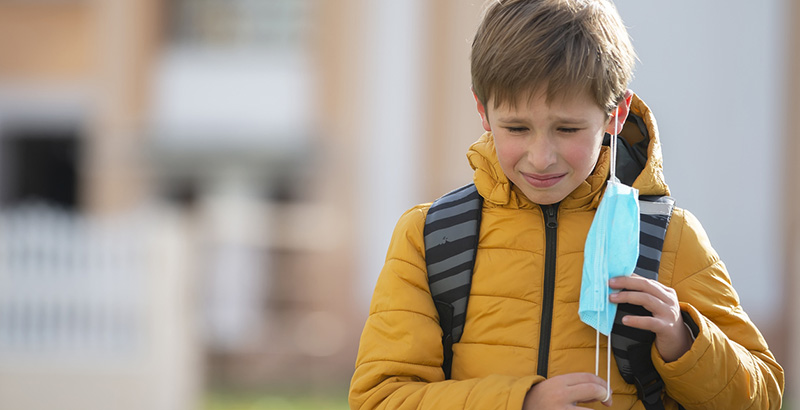Updated, May 21
The debate over mask-wearing went a step further this week, with some states not only saying they would drop mask mandates in schools regardless of Centers for Disease Control and Prevention guidelines, but three — Texas, Iowa and Utah — passing legislation prohibiting mask requirements in schools and other places. This prompted Randi Weingarten, president of the 1.7 million-member American Federation of Teachers, to send a May 20 letter to CDC Director Rochelle Walensky and Education Secretary Miguel Cardona seeking clarification and guidance on 10 separate points related to COVID-19 school safety protocols for next school year.
On May 7, Superintendent Kent Edwards of Kearney Public Schools in Nebraska delivered an explosive message to his community that, outside of a pandemic, would usually be innocuous.
“We are excited to see our students’ faces again.”
About a week before the Centers for Disease Control and Prevention announced that vaccinated people could forgo masks in most indoor and outdoor settings, the 5,900-student Nebraska district scrapped its face-covering mandate.
Now, since the CDC update, school districts across the country are following suit. Governors including South Carolina’s Henry McMaster, Utah’s Spencer Cox and Colorado’s Jared Polis have announced that school systems in their state may relax universal masking mandates for the final weeks of the academic year. And districts such as Cobb Schools in Georgia, Pasco County Schools in Florida and Fargo Public Schools in North Dakota are switching to mask-optional policies in the days and weeks to come.
The recent moves, however, go against recommendations from the CDC, which on Saturday clarified that universal masking and physical distancing are still recommended in schools, even for vaccinated teachers and students.
Confusion over the new guidance has extended not just to schools, but to friends re-learning to navigate social gatherings, retail outlets concerned for the safety of their employees and countless other settings where masks have long been the norm. While about 122 million Americans have been fully vaccinated against COVID-19, including over 2 million educators, youth aged 12 to 15 only last week received clearance for vaccines, and younger students likely will not gain eligibility until early next year.
“Our school guidance to complete the school year will not change,” said CDC Director Dr. Rochelle P. Walensky on Fox News Sunday, adding that the federal agency will work this summer to update its COVID-19 school safety recommendations before the fall.
Next school year, however, may not be soon enough in the eyes of some parents.
Earlier in May, protestors gathered outside the Greenville County, South Carolina school district headquarters chanting, “Unmask our kids.” One woman toted a poster that read, “Follow the science, masks don’t work.” (Research says face coverings do significantly slow the spread of COVID-19.)
“Some families would love to see the masks go away — like today or yesterday. Other families have serious medical concerns. They have people at home with compromised immune systems,” Greenville County Schools spokesman Tim Waller told WYFF News 4 in response to the protests, adding that the district had received about 20 written comments from parents advocating for mask mandates to stay in place.
Like many other hot-button school policy issues throughout the pandemic, Brookings Institution Senior Fellow Jon Valant sees the dispute over masking in schools as a clash more so over political ideology than safety preferences.
“It’s happened over and over again that there is this division in responses to COVID… [that] is highly correlated with the politics of the area,” he told The 74. “The latest case of that may be these school masking rules.”
As schools were first beginning to reopen last fall, Valant’s research found that districts’ decisions about whether to open their doors to students were predicted not by rates of coronavirus spread in the community, but by the share of residents who had voted for Donald Trump in the 2016 election.
“You would expect that the places that are being most cautious about going back to school in person or [that enforce] precautions like mask-wearing would be the places where there’s the greatest immediate threat of COVID transmission,” said Valant. “From what I have seen, that has not been the case.”
Debates over face coverings in schools have left many communities heavily divided. In New Braunfels, for example, a Texas town home to two separate school districts, clashing mask policies have pitted neighbor against neighbor and thrust normally apolitical parents into new roles as activists.
In Harlan, Iowa, it’s not just parents, but also students, who have been left divided by masking policies — quite literally.
The CDC’s announcement last Thursday did not spur a change in protocol for Harlan Community School District, but some students began refusing face coverings in school regardless. So the district started separating unmasked students from their peers.
“Yesterday, I got stopped in the hallway well before I made it to class and pretty much just got put in the auditorium all day,” Jameson Bieker, a high school student who opposes masks told Omaha’s KETV 7 last Thursday.
This isn’t a punishment, but rather an accommodation, said interim superintendent Lynn Johnson.
“We’re trying to find the means to continue to keep educating those students, but yet separate them from the classrooms where masks are required,” she said.
Bieker’s family is suing the school district over its mask mandate, a tactic that anti-mask parents have turned to across the country — largely to no avail.
But as skirmishes play out locally, defending against a pandemic will ultimately continue to be a nationwide effort. Going forward, Valant hopes that leaders look to the country’s top science-informed guidance to decide what COVID-19 safety policies will be appropriate in schools.
“My hope is that the decisions that are being made either locally or in state government are rooted in the advice that states are getting from the federal government,” he said. “And my hope is that the federal government is putting out the best information that it possibly can.”
Get stories like these delivered straight to your inbox. Sign up for The 74 Newsletter


;)
